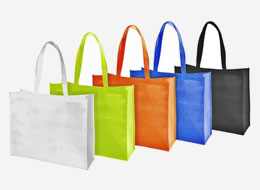 17 Nov 2023
17 Nov 2023The production of nonwoven fabrics typically involves two major processes: web formation and web consolidation. The main web formation methods are carding, air laying, wet laying, spun-bonding, melt-blowing and more recently electro-spinning.
1.Material Preparation: Non-woven fabric, such as engine non-woven fabric, which is made from synthetic fibers or recycled materials, is selected and prepared for the production process. The fabric may undergo treatments such as lamination or coating to enhance its durability and appearance.
2.Cutting: The engine non-woven fabric is cut into appropriate dimensions, usually based on the desired size and shape of the final non-woven bag.
3.Printing (optional): If customization or branding is required, the engine non-woven fabric may undergo a printing process. This can include screen printing, heat transfer printing, or other methods to add designs, logos, or text onto the fabric.
4.Bag Making: The cut pieces of engine non-woven fabric are then fed into specialized non-woven bag making machines. These machines utilize heat, pressure, and ultrasonic technology to bond the fabric together, creating the bag's structure. Handles or straps may also be attached during this step.
5.Finishing touches: After the non-woven bags made from engine non-woven fabric are formed, additional finishing touches may be added. This can include trimming excess fabric, reinforcing seams, adding closures (such as zippers or Velcro), or any other desired modifications.
6.Quality Control: Throughout the production process, quality control measures are implemented to ensure that the non-woven bags made from engine non-woven fabric meet the desired standards. This can involve inspecting the fabric, checking the stitching and bonding, and conducting strength and durability tests.
7.Packaging and Shipping: Once the non-woven bags made from engine non-woven fabric pass the quality control checks, they are packaged and prepared for shipment to the customers.
It's important to note that the specific production process may vary depending on the manufacturer and the intended specifications of the non-woven bags made from engine non-woven fabric.

Non-woven bags have long been popular for their versatility and eco-friendly nature. When it comes to customization, screen printing has traditionally been the go-to method due to its widespread use and cost-effectiveness. However, as the demand for intricate designs and environmentally conscious production grows, alternative printing methods for non-woven bags have emerged.
Watermark
One such method gaining traction is watermark printing, which utilizes water-based elastic glue as the printing medium. This technique, also known as printing, involves blending color paste and water-based elastic glue during the printing process. Notably, no chemical solvents are used, making it an environmentally friendly option. Watermark printing offers strong tinting strength, excellent coverage and fastness, as well as resistance to washing with no residual odor.
Gravure printing
Another prominent printing process is gravure printing, commonly used for producing laminated non-woven bags. This method involves a two-step process where traditional gravure printing is used to print images and text on a film, which is then laminated onto the non-woven fabric. This results in a product with exquisite printing, excellent waterproof performance, and enhanced durability. However, the non-degradable nature of the film used in this process presents environmental concerns.
Heat transfer
Heat transfer printing is also making waves as a specialized printing method for non-woven bags. This technique requires an intermediate medium, wherein graphics are first printed on thermal transfer film or paper and then transferred to the non-woven fabric using a heating device. The advantages of heat transfer printing include exquisite detail, rich layers, and suitability for small area color image printing. However, the high cost associated with this method raises production expenses.
In response to the evolving demands of consumers and an increasing focus on sustainability, these alternative printing methods offer manufacturers and businesses new avenues for creating customized, high-quality non-woven bags. As the industry continues to innovate, striking a balance between aesthetic appeal, functionality, and environmental responsibility remains a key consideration for producers and consumers alike.
GET A QUOTE